Think of your content as a boat. If you just slap something together, it won't take you very far. In fact, it will probably sink. But, when you plan carefully, you can build something to last in stormy weather and keep you afloat.
Similarly, just a little content planning can help you win a Google SERP feature and stand out among the ocean of blue links.
These special results include:
- Knowledge Panels
- AI Overviews
- Featured Snippets
- Local Packs
- Google Ads
- Rich Results
- People Also Ask blocks
- Video Carousels
- Sitelinks
- Buying Guides
In order to get a SERP feature for your brand, you need to optimize your website’s content accordingly. This means making sure your content is clear, helpful, and organized in a way that Google will understand immediately.
If you feel a little green when you see your competitor’s content showcased in any of those special SERP features, all you need is a plan.
In this guide, we’re going to cover some of the most popular SERP features, how they work, and a plan to get your brand featured in them with a little bit of optimization.
Why Should You Care About SERP Features?
Just like anything else on a results page, SERP features can helps you take up more space, get more brand recognition, and even drive traffic to your site.
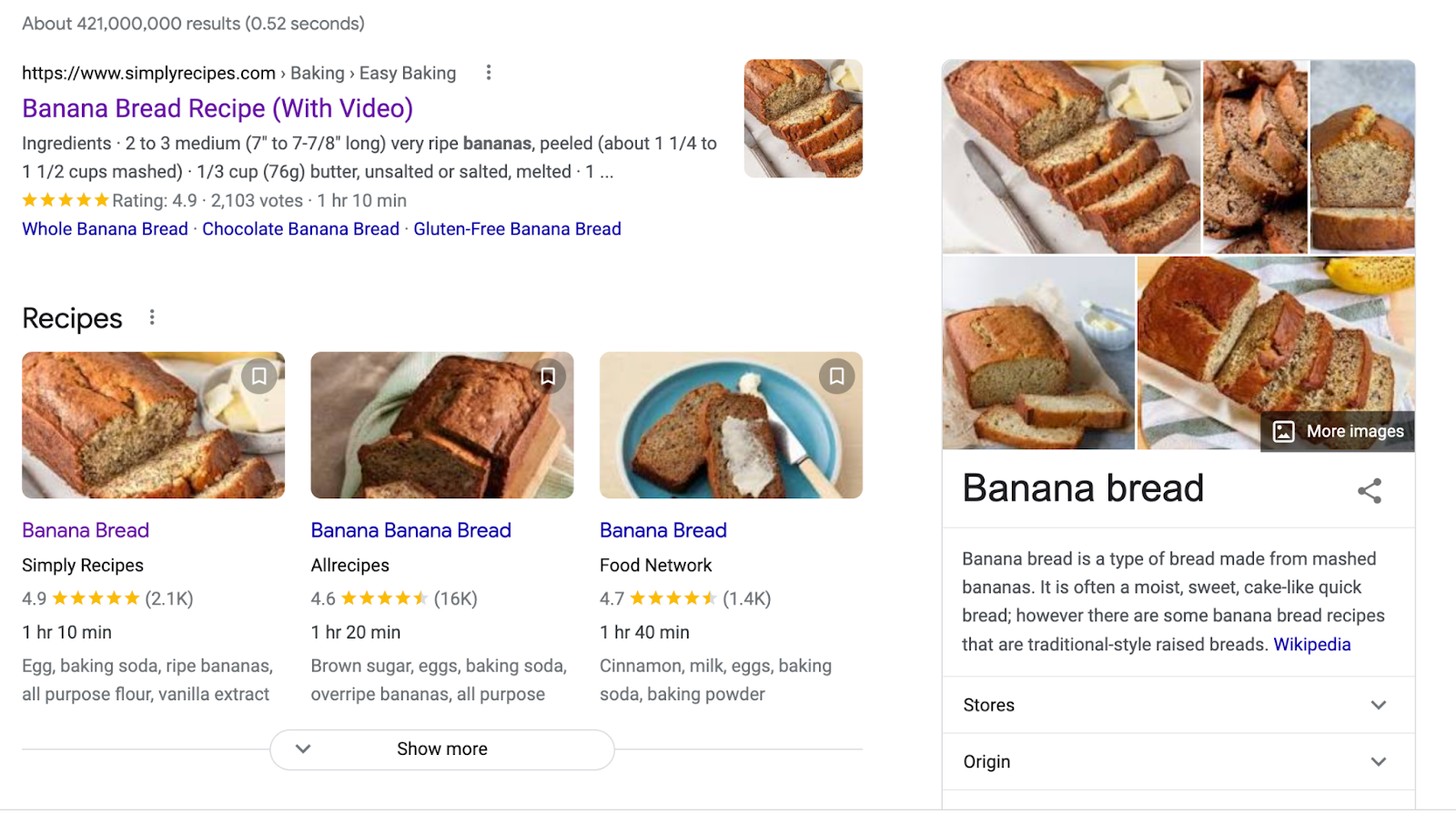
Plus, it goes beyond ranking just your website on Google.
A featured snippet may include a video you posted on your YouTube channel. Although a searcher may not pop on to your website, they’re still watching your content.
This shows Google that your content is worth promoting and it increases brand awareness at the same time.
How to Get Your Brand in SERP Features
In order to get a SERP feature for your brand, you need to optimize your website’s content accordingly. This means making sure your content is clear, helpful, and organized in a way that Google will understand immediately.
One way to make your content clearer in the eyes of Google is by using structured data, which we’ll show you lower in this post.
It also means earning Google’s trust, by establishing your website as an authority on your subject matter and following Google’s guidelines.
Optimizing for SERP Features
If your website is trusted by Google, and you offer content that is clear and helpful, you can target some SERP features with some simple practices.
We’ll show you how to:
- Do keyword research to find SERP features opportunities
- Make your content clear and answer the searcher’s query
- Implement structured data to help Google understand your content
- Submit your sitemap to Google
- Use a tool to optimize your content and track
Do this, and it’s smooth sailing to the top of the SERP.
What’s the Difference Between Paid and Organic SERP Features?
The difference between the two when it comes to SERP features is one relies on spending (potentially lots of) money to get the first ad position (Google Ads and Product Listing Ads); the other on great content and clean code.
There are two conventional approaches to growing your online visibility in search results: paid and organic.
Of course, you’re welcome to try both, but it can be more cost-effective to focus on getting traffic to your site organically.
Plus, there are many ways you can optimize your site for SERP features organically versus only a few with paid.
Keyword Research for SERP Features
With a keyword research tool like Semrush, you can quickly discover the exact queries that trigger the SERP features you’re after.
First, you can look for opportunities in your competitor’s keyword profile.
If your site can provide something better than your rivals occupying a rich result, Google could replace your competitor’s snippet with yours.
Go to Organic Research and type in a competitor’s website to start.

Semrush Organic Research
From the Positions report, you have a few options. First, you could filter the report to only show SERP feature positions your competitor has.
This changes the total number of keywords, traffic, and traffic cost estimations above the table to estimate the domain’s traffic from SERP features only.
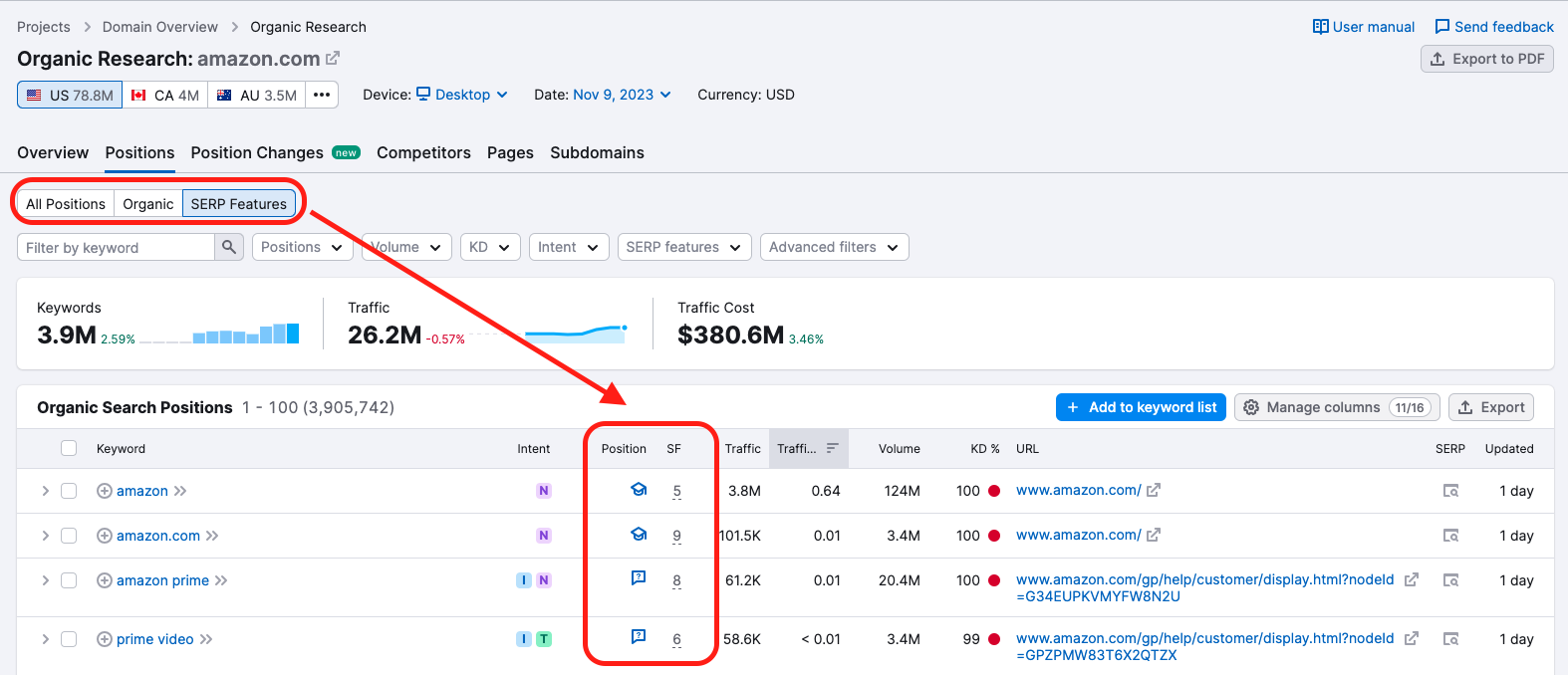
The SERP features that they rank for and gain traffic from will be listed in the Positions column, and the other SERP features on the SERP will be in the SF column.
Hover over the number in the SF column to see the exact SERP features that were triggered by the keyword.
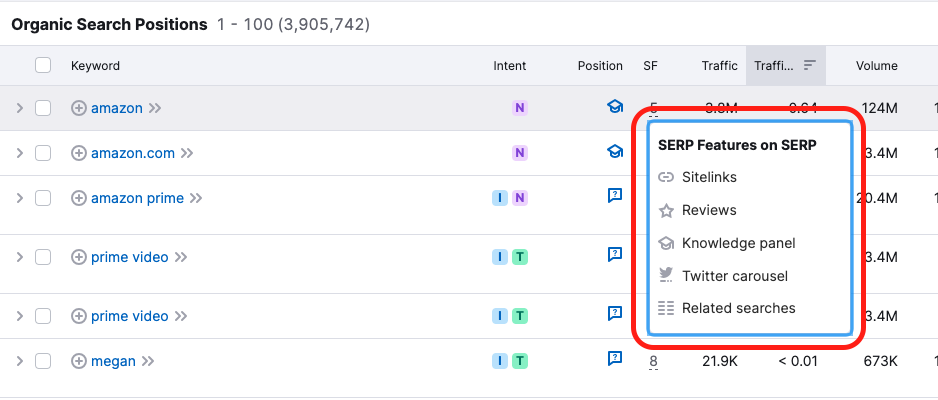
You can also use the SERP features filter above the table to see all the keywords where your rival occupies a rich result (domain ranks in blue), as well as the ones where they don’t (domain doesn’t rank).

Please note: if a SERP feature is the kind that enriches an existing organic result (such as sitelinks, reviews, or an image), it will be found under the Organic filter, and not the SERP features filter.
In April 2023, we upgraded the SERP features data we have in our toolkit, allowing you to analyze more features and even estimate traffic from SERP features. You can read more about that update here.
Then, in the summer of 2024, we made another upgrade allowing you to analyze up to 50 SERP features in Semrush (see the full list below).

We also added the ability to track Google’s new AI Overviews with the Position Tracking and Sensor tools.
The next step in your keyword research for SERP features involves analyzing the landscape of SERP features and how they change over time.
How to Track Historical SERP Feature Trends
Want to gain valuable insights on how your competitors attracted more traffic to their SERPs over time?
You can analyze this data easily with the Position Changes report in the Organic Research tool. Using the dropdown menu, select the custom time period you want to explore.
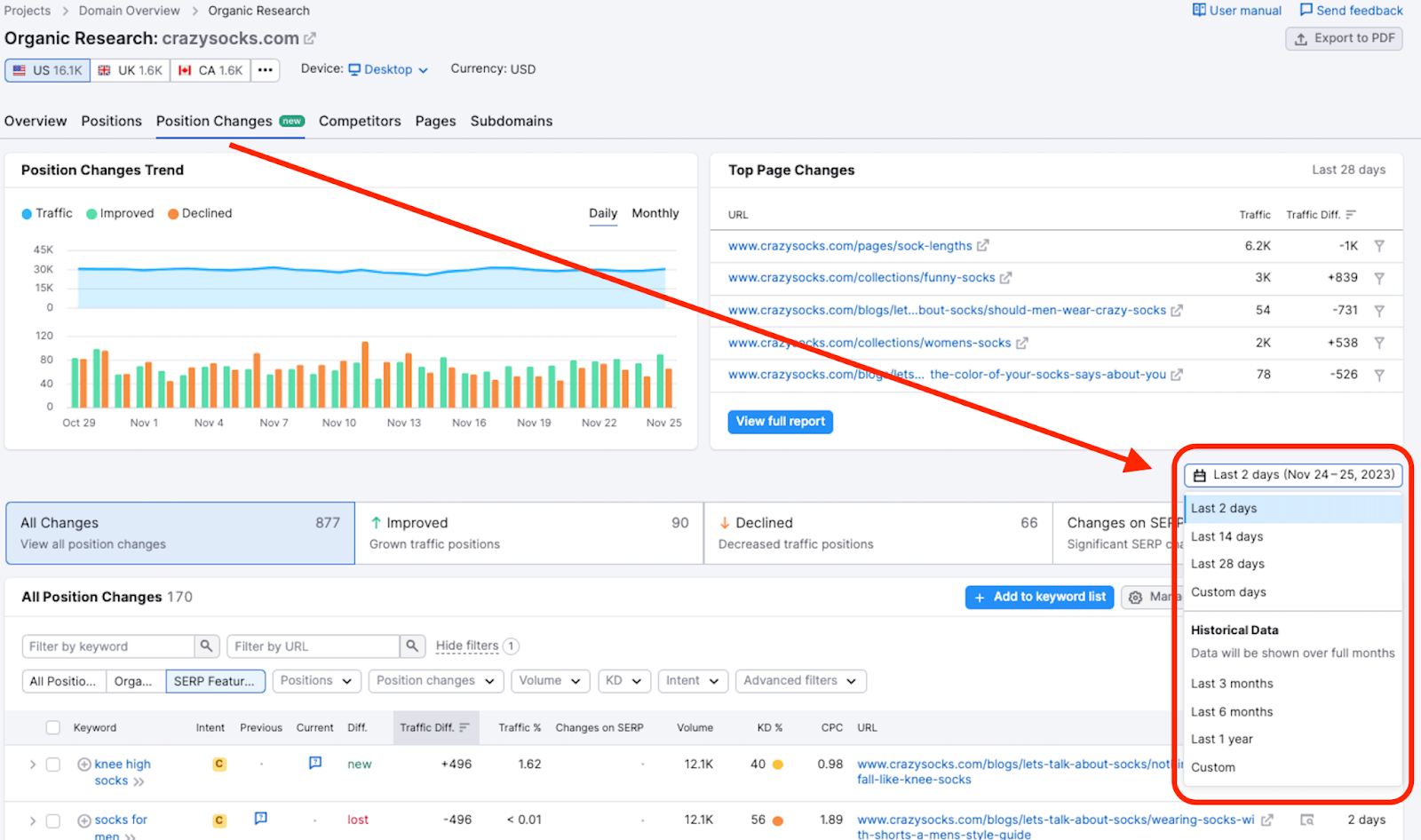
Next, scroll down to the All Position Changes table and select the “Changes on SERP” filter. This highlights the most significant changes on the search page that could have impacted your position in search. For example, if a new SERP feature was introduced and you (or a competitor) lost traffic because of it, you could find that information here.
But what if you want to get even more specific? Let’s say you want to find the SERPs your competitor improved, declined, or recently ranked for. Head to the All Position Changes table, select “SERP Features” and the metrics you’re looking for.
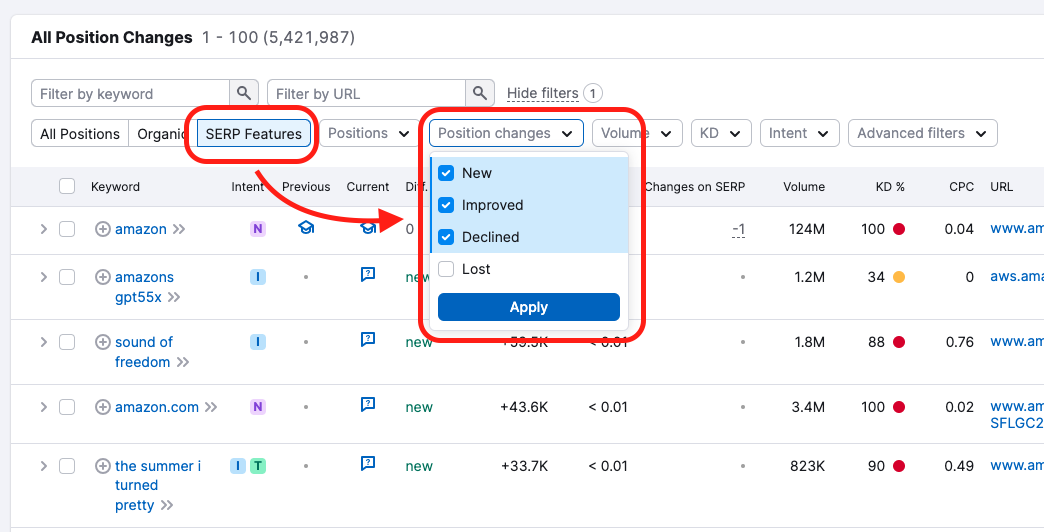
This will bring up a list of pages that shows which direction your competitor is heading in… which could be a valuable opportunity for your brand to explore.
Optimize for SERP Features with Structured Data
Because schema markups and structured data help search engines understand your website better, implementing it can lead to Google giving you rich results on the SERP.
Follow these steps to get started:
- Study structured data and how it works.
- Learn how to build, test, and release your structured data.
- Choose the content assets on your website that you want to target SERP features with.
- Follow the General Structured Data Guidelines and apply them accordingly.
- Mark up the content on your webpages usingschema.org properties. These may apply to reviews, FAQs, job listings, etc. If you already have information in the Knowledge Panel but want it to get updated, use Google’s guide for that.
- Run Google Rich Results Test to check if your content is optimized for SERP features. If implemented correctly, structured data may enable special search result features and enhancements for your website’s content.
Optimize Your Structured Data for Sitelinks
Sitelinks are the additional blue links that accompany an organic search result, leading to different areas of the same site.
This SERP feature can give your brand more room on the results page while also giving users more options on how they’d like to enter your website.
You can optimize your structured data for sitelinks with what Google calls WebSite structured data. Do this by implementing this type of structured data on your homepage.
If you do, Google might reward you with a sitelink search box to get potential searchers that much closer to browsing your site.
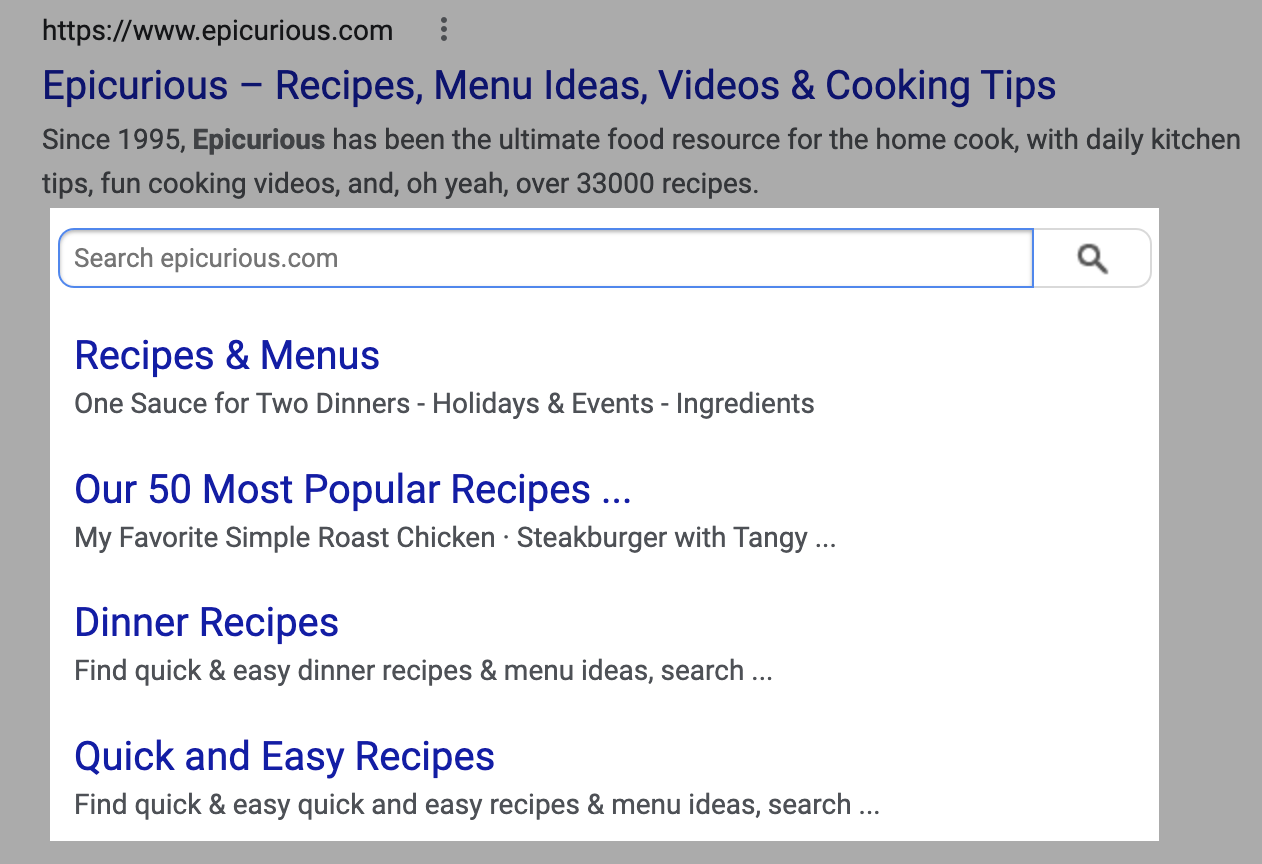
More ways to encourage Google to give your website sitelinks:
- Submit your sitemap (and make sure it’s clean)
- Create breadcrumbs to help crawlers navigate your site
- Validate your website's search box
- Use canonicals correctly
- Use JSON-LD to create structured data (per Google’s recommendation)
Sitelinks are an easy way to take up as much real estate on the SERP as possible. Taking the time to optimize for sitelinks could boost traffic to your site because searchers tend to click on what’s above the fold the most (they’re trying to go snorkeling, not scuba diving).
How Do You Get Rich Snippets?
Rich snippets (now called rich results) are any type of search listing that displays visual or interactive data. So, not every piece of content on your site needs structured data to gain SERP features.
These include ratings, event info, data sets, FAQs, and more. They can appear on any search engine results page.
You can improve your chance of snagging rich results with structured data. Inserting these data markups into the head of your code is an easy way to make sure search engines understand what your article is about and understand the connections between concepts and pages on your site.
And that means a greater chance of winning some more SERP features for your site.
Recipes
Have a site that features recipes? Structured data will be your best friend.
Use JSON-LD to create structured data on your recipe’s page to optimize it for the SERPs:
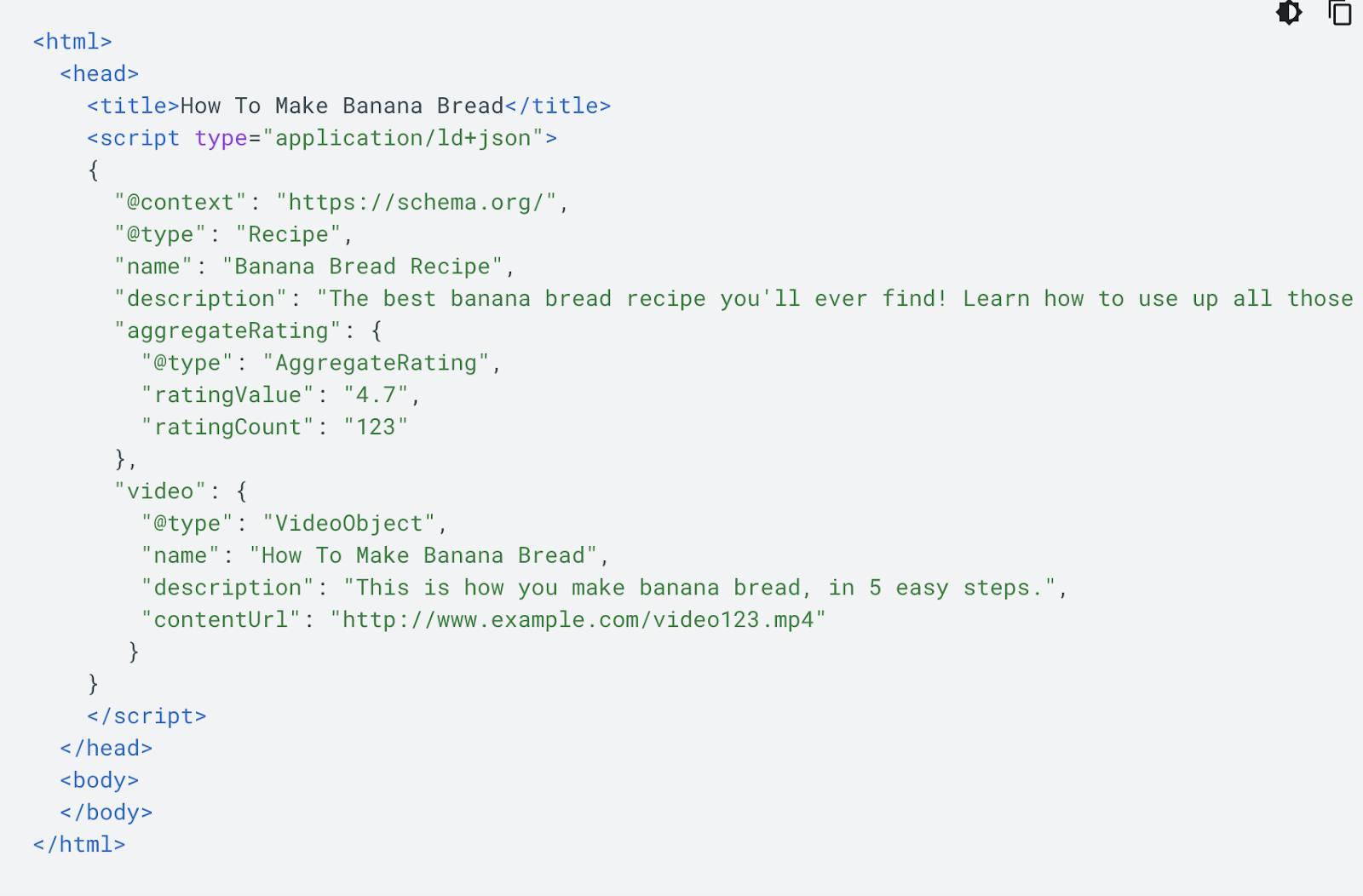
Google also mentions that reviews and visuals (especially videos) can help increase those chances of turning your plain link into a rich result.
Though structured data optimization doesn’t guarantee that you will be present on search result features, following these steps may raise the chances for your content to get them.
Reviews

On the topic of recipes, do you notice those 5 stars right above the sitelinks? You can also use structured data to display review ratings as a rich result in the form of a review schema.
This helps show trust to your readers and is another way to take up more search real estate with clean code.
As you get more into structured data, you can use the Semrush Site Audit Markup report to check your markups and see what percentage of your website uses Schema.
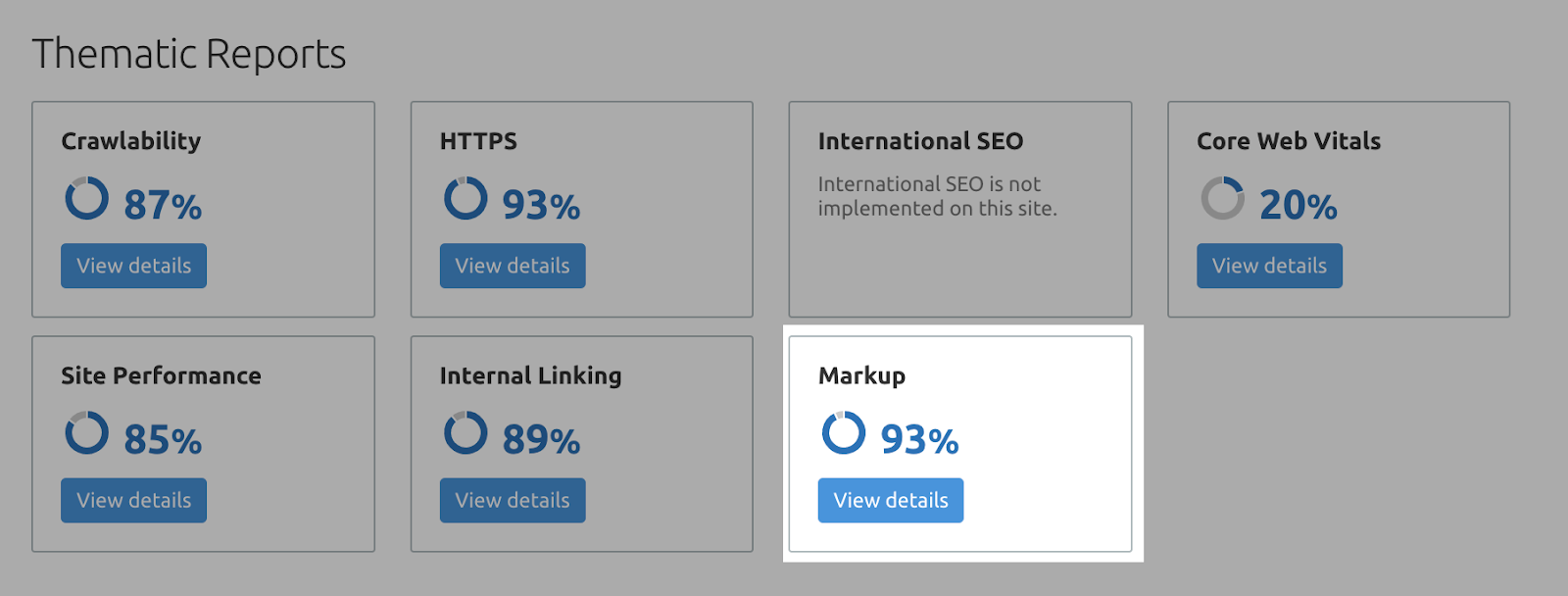
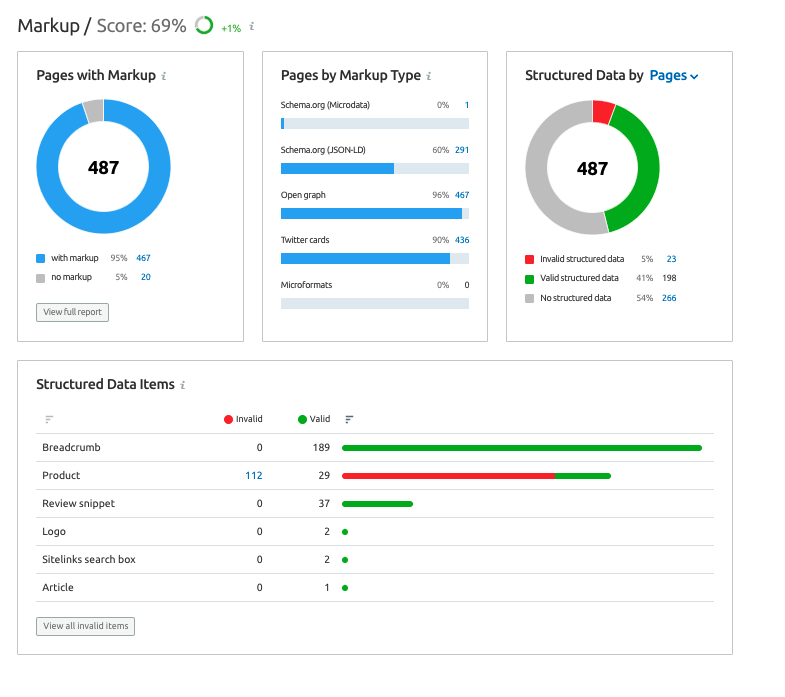
Optimize Your Content for Featured Snippets
Optimize for featured snippets by creating content that is better than your competitor’s. Easier said than done, right?
While it's never easy to overtake a strong competitor, there are some simple methods to encourage Google to pick your page for a featured snippet.
First, it’s important to know the most common types of featured snippets. These are:
- Lists
- Tables
- Videos
- Paragraphs (e.g. definition box)
Part of creating content that’s better than your competitor’s content is making it easy to read. Lists, tables, and videos can all be easier to digest than long paragraphs. So, to target a featured snippet, make sure your content is in bite-size chunks.
The easier it is for people to read, the easier it will be for Google to understand your content.
You can make your content easier to read with the help of tools like the On Page SEO Checker (featured below) and the SEO Writing Assistant (SWA).
The SWA tool can grade your readability score as you write in real-time, helping you hone in on hard-to-read sentences and make them easier to read.
The On Page SEO Checker analyzes the readability score of top-ranking pages in the SERPs (shown below). It helps you understand whether or not you need to make your content easier to read to have a better chance of beating your SERP competitors.
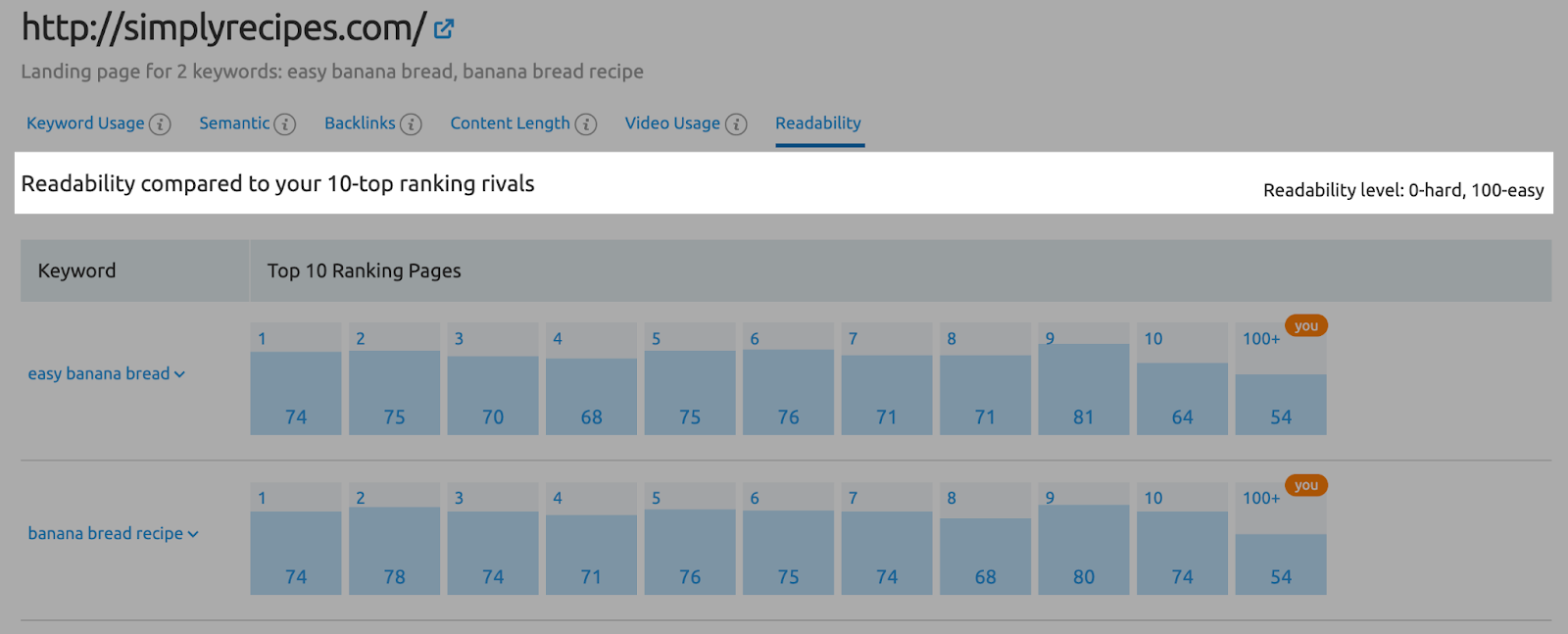
Making content easy to digest often depends on how you structure your content. That includes:
- Chunking up your content into bite-sized paragraphs
- Using numbered or bulleted lists where it fits
- Making your content easy to skim with headers (including h2s, h3s, h4s, etc.)
- Adding images, GIFs, or videos that add meaning to your content
Optimizing for lists and tables can be straightforward. Use the right HTML format for tables and lists along with better content than your competitors and there is a good chance you’ll snag the snippet.
Google favors content that makes it easy to find answers.
How so?
Making it easy to find the question (aka query) that’s at hand and making it just as easy to find the answer. Try to structure your content in a Q&A format to grab the definition box and secure position 0.
Featured snippets that feature videos seem to function in the same way: make it easy for Google and readers to identify what question you’re answering.
Here’s some insight from How To Optimize for Google Featured Snippets [Research]:
29% of keywords with a featured snippet started with a question-based word, such as “why,” “do,” and “can.”
Boost your chances by phrasing your title and headers with question-based words. And, as always, make sure that the keywords you use match search intent. You can find this out with the Search Intent filter in the Keyword Magic Tool.
Also, look for long-tail keywords. Keywords like these tend to be more specific, which translates into more specific search intent.
Why You Should Optimize Your Content for Featured Snippets
According to the study we conducted in 2020, 19% of SERPs at the time had featured snippets. Another fun fact is that these featured snippets take up 50% of a mobile screen.
The big takeaway here is that you need to optimize for featured snippets if you want to get your audience’s attention while they’re using search on their mobile devices.
Pro tip: Read the Featured Snippets Report manual for more help.
Featured snippets, especially on mobile, take up a large chunk of real estate on the screen. And you can own that real estate with your organic content—potentially landing your brand a huge amount of visibility.
Three Tools to Optimize Your Content for Featured Snippets
Three Semrush tools in particular that can help you in this step are On Page SEO Checker, SEO Content Template, and SEO Writing Assistant.
We recommend using all of the three tools to optimize your existing pages and adding new content to your site to win those featured snippets.
This tool lets you enter your landing pages and target keywords and then returns with specific optimization ideas you can take to help your existing pages both rank and acquire SERP features on your target keywords.
This tool will outline a template for new content that specifically targets your keyword and SERP features. This will help you get started when you want to target a new keyword that you are currently not targeting.
Check the potential SEO performance, readability, and originality of your content pieces, based on recommendations given by SEO Content Template.
How to Get SERP Features with People Also Ask (PAAs)
The best way to rank for PAAs is to optimize your content that is already performing well with question-based keywords.
A study on PAAs we conducted in 2020 found that the overwhelming majority of content that went on to appear in this SERP feature was already ranking in the SERP’s top 3 organic results.
If you’re already ranking in the 3, what’s the point of trying to rank for this type of SERP feature?
Hint: it’s a point we keep harping on—web real estate. The more space your website takes up on the SERP, the better the chance is that people will click through to your site. Other than that, it also increases brand awareness.
Unsurprisingly, the study also found that 86% of PAAs were triggered by question-based keywords.
One way you can tackle this part of your winning SERP strategy is by looking at the PAAs targeted by a keyword your content ranks for already. For instance, if you rank for “use regular bananas for banana bread,” then consider turning that into a question to target the PAA.
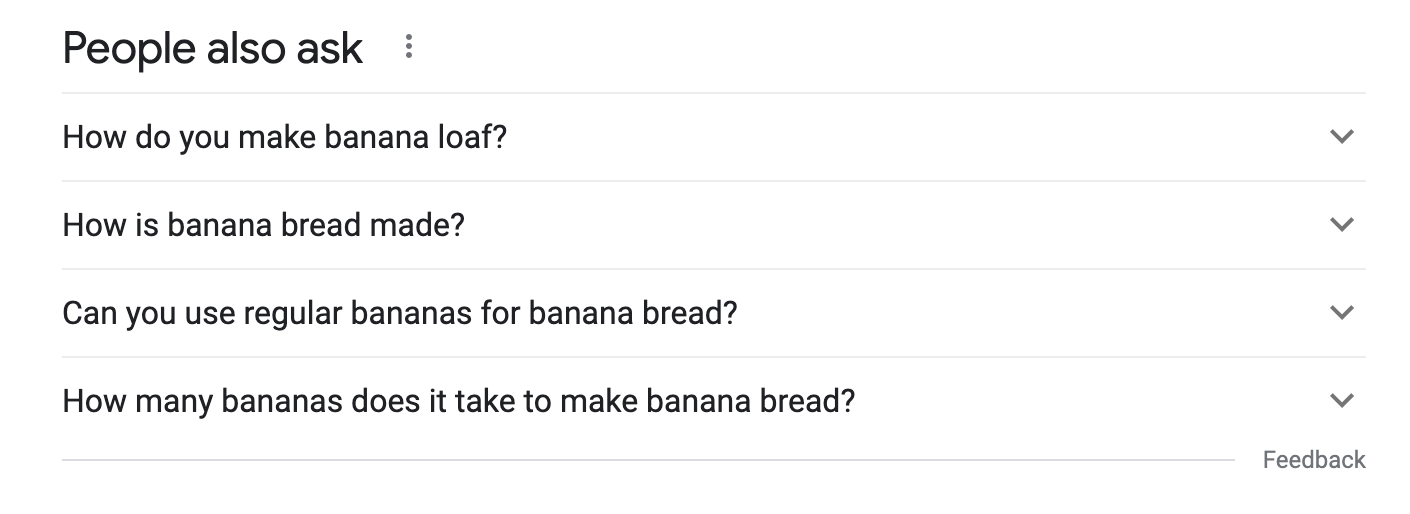
How to Find Keywords for PAAs
Another way is by entering a core keyword in the Keyword Magic Tool, which will generate as many related search terms as possible.
Then, you can set a Questions filter to turn a search query into a question-based keyword. Also, feel free to take a question you see on the PAAs and pop it into the Keyword Overview tool to see the potential traffic your content could get if it ranked for this SERP feature.
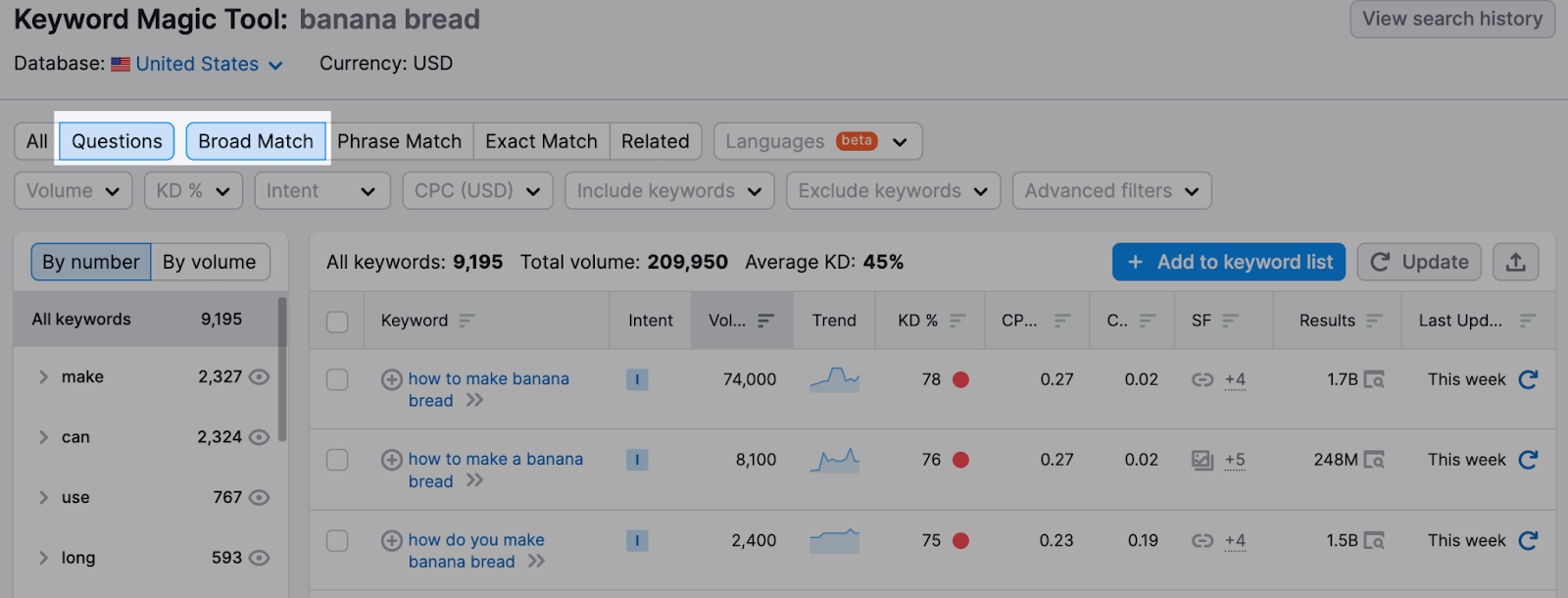
You can also find keywords that trigger a PAA result with the Keyword Magic tool with the SERP Features filter. It’s under Advanced filters and you can use it to see which keywords trigger all kinds of SERP features.
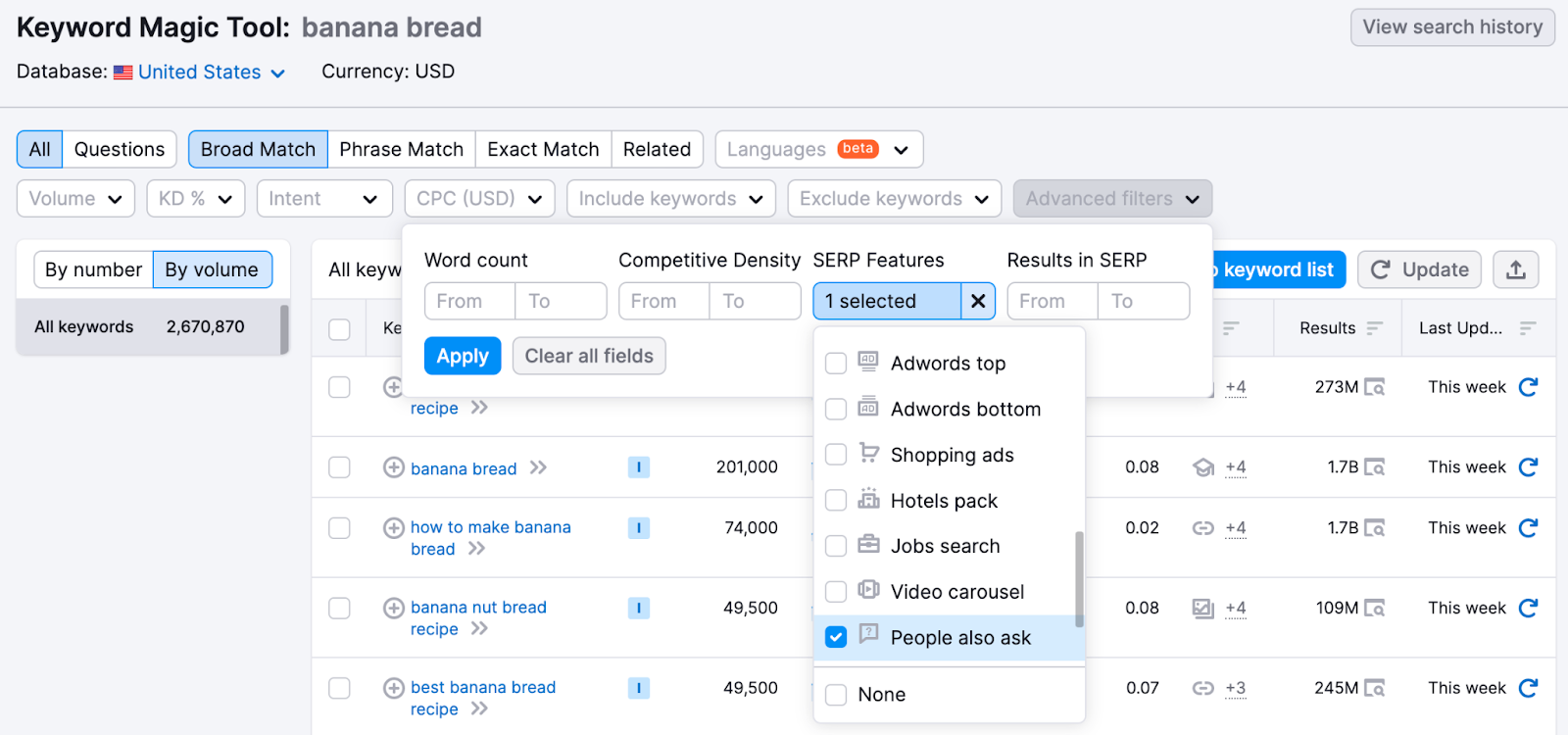
It can help to use the Questions filter with the SERP Features to find the best queries to target for your content strategy.
You can pick the most fitting keywords for your site by clicking the button with the plus sign and sending them to the Keyword Strategy Builder to save your research.
In Keyword Strategy Builder, you can gather all the keywords you are working with, and group them into thematic lists to groom your list of keywords.

Track Your Progress as You’re Optimizing for SERP Features
From Keyword Strategy Builder, you can automatically send keywords to the Position Tracking tool by clicking the “Send to other tools” button and selecting Position Tracking to either create a new campaign or connect to an existing campaign.
There, you can start monitoring your own, as well as your competitors’ rankings and all of the triggered SERP features.
See Which SERP Features Are Right for You
Remember that success takes experimentation, data gathering, SERP analysis, and of course, patience. Hopefully, you’re ready to navigate through the sea of SERP results right to the surface.
Try out the following to get more SERP features:
- Use keyword research to inform your SERP feature strategy
- Create and optimize content to make it readable and concise
- Use structured data to help Google understand your content
- Submit your sitemap to Google
- Set up Position Tracking to monitor your progress
Now go try out some of these strategies and let us know what works best for you.
